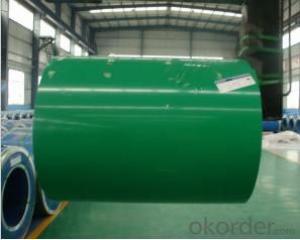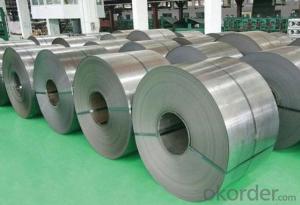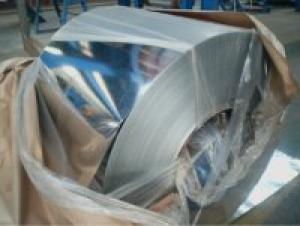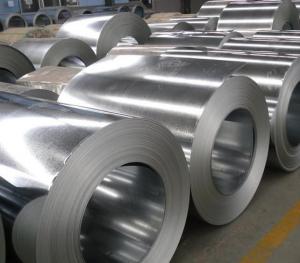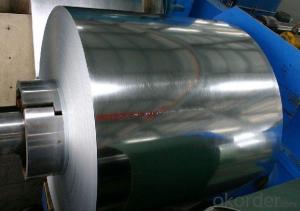Competitive Prepainted Galvanized Steel Coil
- Loading Port:
- Shanghai
- Payment Terms:
- TT OR LC
- Min Order Qty:
- 30 m.t.
- Supply Capability:
- 10000 m.t./month
OKorder Service Pledge
OKorder Financial Service
You Might Also Like
Basic Info.
Model NO.:CGCC, SGCC, DX51D, DX51D+Z, TDC51D, TDC51D+Z, G550
Surface Treatment:Coated
Certification:ISO, SGS, BV
Technique:Hot Rolled
Standard:ASTM, JIS, GB, AISI, DIN, BS
Application:Building Material, Steel Structure Buildings
Edge:Mill
Stock:Stock
Steel Grade:Q195
Thickness:0.12-1.5mm
Width:600-1500mm
Zinc Coating:30g-275G/M2
Color:as Ral or Sample
Paint Thickness:Top 15-25um+Back 8-10um
Painting Type:PE, PVDF, Smp, Hdp, as Requested
Delivery Day:15-30 Days
Production Ability:30000mt/Month
Coil Weight:3-5 Ton
Export Markets:Global
Additional Info.
Packing:Sthandar Seaworthy Package
Standard:JIS G3302-1998/EN10142/ASTM
HS Code:72107010
Production Capacity:30000mt/Month
Product Description
NAME: Competitive prepainted galvanized steel coil for building
SIZE:
Thickness: 0.12-1.5mm
Width: 600mm,750mm,762mm,900mm,914mm,940mm,1000mm,1050mm, 1090mm,1100mm,1200mm, 1219mm, 1250mm,1250mm
Length: According to the customer's request
Hardness:Soft( around HRB 65) ,full hard (HRB90-95)
Strength of Extension: more than 300Mpa
Yield Strength:370-380Mpa
Thickness tolerance: +/-0.02 mm(0.01 as you requested)
Width tolerance:+/ -2.0mm
ZINC, PAINT & COLOR:
Zinc coating: 30-275G/M2
Paint thickness: Top 15-25um + Back 8-10um
Paint: Epoxy Polyester, silicon modified polyesters, polyvinylidene fluoride, high-durability polyester
| Base mental | hot galvanized /galvalume steel coil |
| Thickness | 0.12-1.5mm |
| Width | 600-1500mm |
| Coil Weight | 3-5ton |
| Quality: | DX51D DQ CQ |
| Color | all RAL colors or as per customers' sample |
| Zinc-coating | 30g/m2-275g/m2 |
| Coil ID | 508mm-610mm |
| Packing | standard seaworthy package |
| Technique | cold rolled, hot-dipped galvanizing, color coated |
| Painting | Top and bottom: 20mic+5mic RMP Back: 8mic-10mic |
| Tolerance | Thickness: +/-0.02mm Width: +/-2mm |
| Description | Pre-painted Steel Coil uses hot galvanized steel as its basic material, factory adopts advanced equipment to degrease, rinse, transform the galvanized steel, then make primary and refined lavation to the steel coils. |
| application | They are mainly applied for steel structure buildings, household appliance, furniture, transportation and other industries |
| feature | Pre-painted Steel Coils have excellent performance of decoration, corrosion resistance etc. |
| The special order can be negotiated | |
- Q:What is the type of stainless steel used in knifes.
- If your talking about a folding pocket knife, I think that it's basically six one way and a half dozen the other. I actually do prefer stainless for my pocket knives. I don't want to oil a knife to the degree I feel carbon requires, only to then stick it my pocket to attract dirt to the knife and oil to my pants. I'm the exact opposite on sheath knives though. I like 1095 carbon steel, plain edge sheath knives. I'll thrash on them HARD, and I rarely have major edge problems. Of course, I require them to be coated with some kind of powder coat or the like, because they can rust, but I do try and keep them clean and dry when in the sheath, so they won't pit the uncoated edge. My reasons for this sheath knife preference is multi-fold. First, these knives are simply affordable. I don't spend $80 dollars on a outdoors sheath knife. I use the tool too hard to want to spend more. I don't like the more traditional stainless steels such as AUS-8, 420HC, and 440C (not to mention the HORRENDOUS 440A) because I feel that the all else being equal, a stainless blade will bend before a carbon blade will break. I also think that carbon holds an edge at least as well, if not better, than traditional stainless, and it's much easier to hone. I don't know much about these new laminates, other than the very hard, but not so tough. They seem to be POSSIBLY too brittle for my use. That, combined with the fact that they cost a FORTUNE, means that I just won't be considering them.
- Q:I wanted to know what is steel fabricating?
- Steel Fabricating/or Steel Fabricators is just a fancy way of saying that they sell steel products and a variety of related services. Thomas steel products has a wide range of steel products and services, from Windsor Republic Door Dist, Tie Wire, Steel Doors Frames, Snap Ties, S Parker Hardware Distributor, Reinforcing Steel Detail Drawings Avail, Rebar Fabrication, o_O.
- Q:How are steel coils used in the production of automotive body panels?
- Steel coils are used in the production of automotive body panels by being processed and shaped into the desired form through techniques like stamping, cutting, and bending. These coils provide the necessary strength and durability required for the structural integrity of the body panels, ensuring the safety and performance of the vehicle.
- Q:What are the different types of steel coil edge conditioning methods?
- There are several different types of steel coil edge conditioning methods, including slitting, trimming, chamfering, deburring, and edge rolling. Slitting involves cutting the coil into narrower strips, while trimming removes any excess material from the edges. Chamfering is the process of creating a beveled edge, while deburring removes any burrs or sharp edges. Edge rolling is another method used to smooth and shape the edges of the steel coil.
- Q:What are the common surface defects in steel coils?
- Steel coils commonly have surface defects, including scratches, pits, indentations, stains, and rust spots. Scratches may occur due to mishandling or processing, and their depth and length can vary. Pits are small depressions caused by impurities in the steel or during manufacturing. Indentations are similar but larger and more noticeable. Stains can result from chemicals, water, or other contaminants coming into contact with the steel. Rust spots form when the steel is exposed to moisture or corrosive elements, leading to iron oxide formation. These defects can impact the appearance, quality, and performance of the steel, necessitating their resolution to ensure the intended use of the coils.
- Q:Does SA use its own iron ore to produce steel for construction or do we rely on imports?
- There is a ludicrous mixture of the two at present. We export a large percentage of our steel to China predominantly but also to other regions then import what ever the shortfall is on the local market, often at inflated prices. The company I work for obtains all its steel from only one supplier, who we have shares in, and under the counter cash incentives are the order of the day, I keep myself above water by refusing the cash and sign no documents relating to those dealings, I'm not prepared to go to prison for a cash bonus.
- Q:Please explain why steel is denser than wood.
- A steel atom has more mass than wood becaue it has a larger number of protons and neutrons in it's nucleus. So steel packs more mass (more matter) into the same space as wood. Density is mass/volume. If you have a 1 cm cube of steel and a 1 cm cube of wood they are the same volume (1 cubic cm) but the steel has more matter in that volume and therefore is denser.
- Q:Is steel harder than iron or is iron harder than steel?Please explain... and help!Thanks
- steel is harder than iron Iron is a chemical element. It is a strong, hard, heavy gray metal. It is found in meteorites. Iron is also found combined in many mineral compounds in the earth's crust. Iron rusts easily and can be magnetized and is strongly attracted to magnets. It is used to make many things such as gates and railings. Iron is also used to make steel, an even harder and tougher metal compound. Steel is formed by treating molten (melted) iron with intense heat and mixing it (alloying) with carbon. Steel is used to make machines, cars, tools, knives, and many other things.
- Q:What are the main factors that affect the strength of steel coils?
- The main factors that affect the strength of steel coils include the quality and composition of the steel used, the manufacturing process, the thickness and width of the coils, and any heat treatment or tempering applied to the steel. Additionally, factors such as storage conditions, handling, and transportation can also impact the strength of steel coils.
- Q:i cant find this stuff about steel:conductivitystrengthcorrosion resistancecommon applicationsif you know of any interesting facts, i could use those 2!thanx!
- go okorder and search for steel.......
1. Manufacturer Overview |
|
|---|---|
| Location | |
| Year Established | |
| Annual Output Value | |
| Main Markets | |
| Company Certifications | |
2. Manufacturer Certificates |
|
|---|---|
| a) Certification Name | |
| Range | |
| Reference | |
| Validity Period | |
3. Manufacturer Capability |
|
|---|---|
| a)Trade Capacity | |
| Nearest Port | |
| Export Percentage | |
| No.of Employees in Trade Department | |
| Language Spoken: | |
| b)Factory Information | |
| Factory Size: | |
| No. of Production Lines | |
| Contract Manufacturing | |
| Product Price Range | |
Send your message to us
Competitive Prepainted Galvanized Steel Coil
- Loading Port:
- Shanghai
- Payment Terms:
- TT OR LC
- Min Order Qty:
- 30 m.t.
- Supply Capability:
- 10000 m.t./month
OKorder Service Pledge
OKorder Financial Service
Similar products
New products
Hot products
Hot Searches
Related keywords
